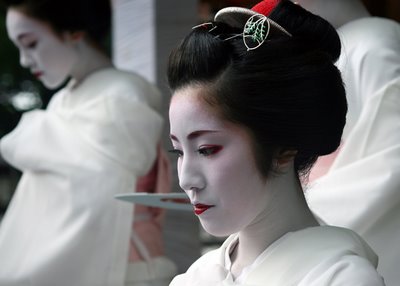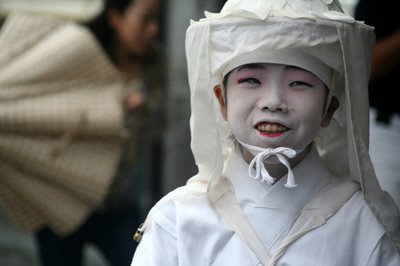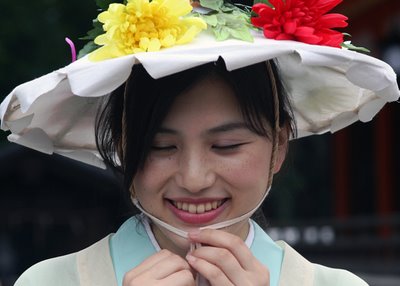I'm headed to Kyoto for
Jidai Matsuri: The Festival of Ages. I haven't been to Kyoto since July(way too long) but here are some of the photos I took during the summer and never got around to sharing. Enjoy!

A young, first year maiko on her way to an appointment during Gion Matsuri. Geiko still use traditional, oiled paper umbrella in the rain and snow. This was my first time actually seeing a maiko or geiko use one. Breath-taking. This is also the first image taken with my new camera (^-^)/ I'm still learning how to use it. Non-stop pouring rain + fast moving maiko = a great learning experience! The blur helps conveys the hustle and bustle of the crowded street, the young maiko rushing through the crowd to her appointment, and the dreary, dripping rain. It looks ethereal, like a scene from a dream, which is exactly the way I felt when I shot it.
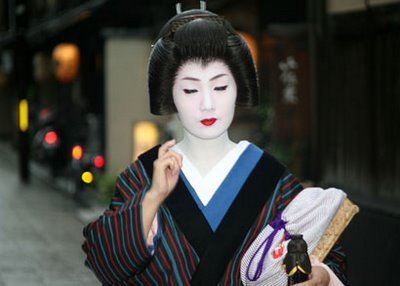
Eyes Wide Closed: Gion. A geiko making her daily communte through the streets of Gion. Geiko wear wigs called katsura, with almost no ornamentation (compared to maiko, who style their own hair, which is adorned with many kanzashi, or flowered ornaments). Of course she blinked the exact moment I pressed the shutter, but what a perfect face.

A young geiko waiting outside the Ichiriki Teahouse in Gion with her client. Customers pay about $200 dollars an hour for the privledge of spending time with geiko (kyoto dialect for geisha), but having money is not the only requirement. Customers must have a relationship with an ochaya, a place where geiko entertain, in order to make an appointment, and being introduced to an ochaya is no simple task. The refined manners of Kyoto dictate that charging a customer at the end of the night is a no-no. With bills often running past 5,000$ a night, Ochaya must have a relationship based on trust, so that they can rest assured that the bills that they send to their customers once a month will be paid.
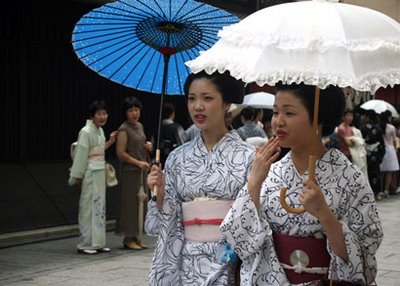
Two maiko make their way through the busy streets of Gion, sheltered from the sweltering summer sun by their umbrellas. Daytime casual: No white makeup, no heavy silk kimono. Just cotton yukata and lip gloss (^-^). I've never seen a maiko with a western umbrella before (right). Interesting. Also love the way the two older women watched them pass with awe, reverence and pride.
It is a Japanese custom for women to cover their mouths when smiling,laughing, and even sometimes, speaking. This young maiko was laughing as she talked with her friend, which is as she talked with her friend, which is why her hand is raised just so.
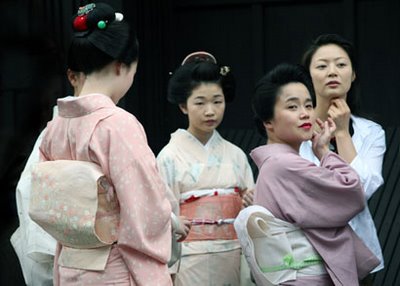
An older "sister", an accomplished and high ranking geiko, accompanying a few younger maiko, or apprentice geisha, to a tea ceremony held at the famous Ichiriki Teahouse. The way the older women on the right hold themselves, and the sensual way they touch themselves, even in such a casual way....
 Makiko, maiko of Gion Kobu, also served as a Lady-in-Waiting to Yodogimi (Suzuko).
Makiko, maiko of Gion Kobu, also served as a Lady-in-Waiting to Yodogimi (Suzuko). Sakiko, another young maiko of Gion Kobu, shades herself with an elaborate fan.
Sakiko, another young maiko of Gion Kobu, shades herself with an elaborate fan.

 Jidai Matsuri, Kyoto`s Festival of Ages, started as a way to revitalize Kyoto after Japan's capitol moved to Tokyo. It has now grown to include over two thousand participants (Kyoto residents, including Maiko and Geiko) dressed in authentic period costumes from throughout Japan`s history valued at over $25 million.
Jidai Matsuri, Kyoto`s Festival of Ages, started as a way to revitalize Kyoto after Japan's capitol moved to Tokyo. It has now grown to include over two thousand participants (Kyoto residents, including Maiko and Geiko) dressed in authentic period costumes from throughout Japan`s history valued at over $25 million.


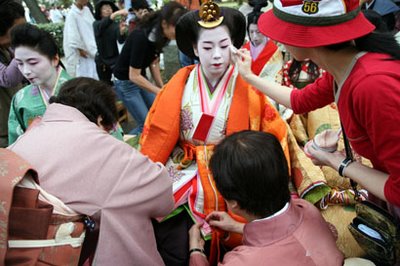
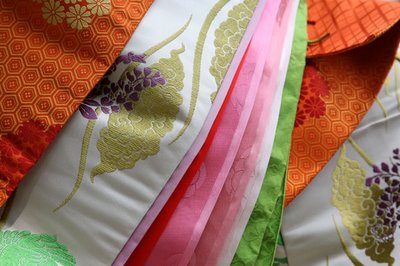
 Colors and patterns of the "juni-hitoe" (12 layers- a rather arbitrary number, as some women wore as many as 20) reflected many things, including: rank, seasons, directions, virtues, and elements of the earth as they related to spirits of nature. The multiple layers also helped in staying warm in winter. Eventually, sumptuary laws of the Edo Period standardized the number of layers to five.
Colors and patterns of the "juni-hitoe" (12 layers- a rather arbitrary number, as some women wore as many as 20) reflected many things, including: rank, seasons, directions, virtues, and elements of the earth as they related to spirits of nature. The multiple layers also helped in staying warm in winter. Eventually, sumptuary laws of the Edo Period standardized the number of layers to five.
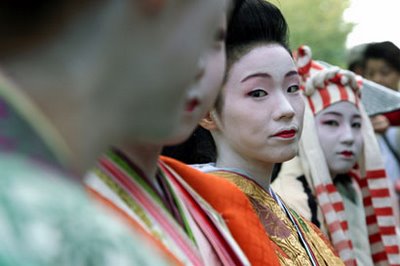



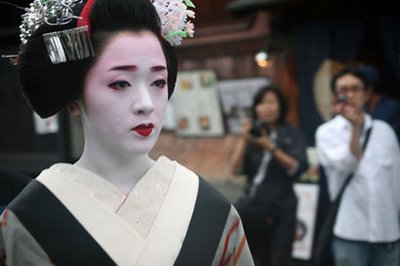 Almost Famous: Kotoha, A young, high rank maiko named Kotoha makes her to the big party at the Ichiriki teahouse after the main procession of Yamahoko Junko last July.
Almost Famous: Kotoha, A young, high rank maiko named Kotoha makes her to the big party at the Ichiriki teahouse after the main procession of Yamahoko Junko last July.  A young, first year maiko on her way to an appointment during Gion Matsuri. Geiko still use traditional, oiled paper umbrella in the rain and snow. This was my first time actually seeing a maiko or geiko use one. Breath-taking. This is also the first image taken with my new camera (^-^)/ I'm still learning how to use it. Non-stop pouring rain + fast moving maiko = a great learning experience! The blur helps conveys the hustle and bustle of the crowded street, the young maiko rushing through the crowd to her appointment, and the dreary, dripping rain. It looks ethereal, like a scene from a dream, which is exactly the way I felt when I shot it.
A young, first year maiko on her way to an appointment during Gion Matsuri. Geiko still use traditional, oiled paper umbrella in the rain and snow. This was my first time actually seeing a maiko or geiko use one. Breath-taking. This is also the first image taken with my new camera (^-^)/ I'm still learning how to use it. Non-stop pouring rain + fast moving maiko = a great learning experience! The blur helps conveys the hustle and bustle of the crowded street, the young maiko rushing through the crowd to her appointment, and the dreary, dripping rain. It looks ethereal, like a scene from a dream, which is exactly the way I felt when I shot it. Eyes Wide Closed: Gion. A geiko making her daily communte through the streets of Gion. Geiko wear wigs called katsura, with almost no ornamentation (compared to maiko, who style their own hair, which is adorned with many kanzashi, or flowered ornaments). Of course she blinked the exact moment I pressed the shutter, but what a perfect face.
Eyes Wide Closed: Gion. A geiko making her daily communte through the streets of Gion. Geiko wear wigs called katsura, with almost no ornamentation (compared to maiko, who style their own hair, which is adorned with many kanzashi, or flowered ornaments). Of course she blinked the exact moment I pressed the shutter, but what a perfect face. A young geiko waiting outside the Ichiriki Teahouse in Gion with her client. Customers pay about $200 dollars an hour for the privledge of spending time with geiko (kyoto dialect for geisha), but having money is not the only requirement. Customers must have a relationship with an ochaya, a place where geiko entertain, in order to make an appointment, and being introduced to an ochaya is no simple task. The refined manners of Kyoto dictate that charging a customer at the end of the night is a no-no. With bills often running past 5,000$ a night, Ochaya must have a relationship based on trust, so that they can rest assured that the bills that they send to their customers once a month will be paid.
A young geiko waiting outside the Ichiriki Teahouse in Gion with her client. Customers pay about $200 dollars an hour for the privledge of spending time with geiko (kyoto dialect for geisha), but having money is not the only requirement. Customers must have a relationship with an ochaya, a place where geiko entertain, in order to make an appointment, and being introduced to an ochaya is no simple task. The refined manners of Kyoto dictate that charging a customer at the end of the night is a no-no. With bills often running past 5,000$ a night, Ochaya must have a relationship based on trust, so that they can rest assured that the bills that they send to their customers once a month will be paid.



